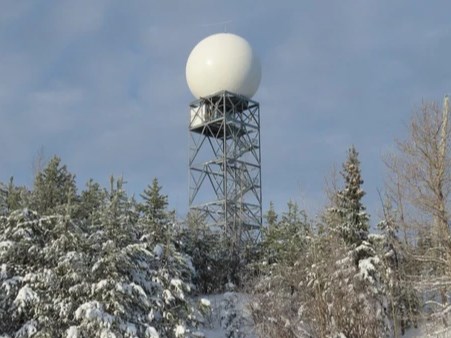A new and improved weather radar station is now scanning the sky from Baldy Hughes.
It takes over from one that had been in place since 2003 and features updated technology to help meteorologists to "better detect and predict severe weather," Environment Canada spokesperson Samantha Bayard said in an email to the Citizen.
The new S-band radar sports a 240-kilometre Doppler range, double the distance of its C-band predecessor.
The extension represents a 400-per-cent increase in the area it covers which, according to Environment Canada, should not only give residents more time to brace themselves for adverse conditions - or prepare for a pleasant weekend at the lake - but allow for better overlap with neighbouring radars in the case of an outage.
Although most of that redundancy is focused on the Lower Mainland, the new Baldy Hughes array shares some space with the now-upgraded stations in Spirit River, Alberta, which has a 400-kilometre range, at Silver Star Mountain near Vernon, and once it's completed, a new one at Halfmoon Peak on Vancouver Island.
The scan frequency is six minutes, down from 10 the old system provide, so that data can be collected and updated more quickly.
"This is really important in rapidly developing situations," Bayard said.
The new radars also feature "dual polarization" that allows meteorologists to "measure the particles not only in the horizontal but also in the vertical to better identify the shapes of the targets detected by the radar."
The upshot? It will allow meteorologists to distinguish between heavy rain, hail, and snow and better detect non-weather phenomena such as birds, bugs, and even tornado debris. "This will also be key in aviation forecasts of icing," Bayard said.
And the new radar provides "reduced attentuation," or more to the point, higher power that gives "better storm penetration performance."
"This allows forecasters to see deep into dense weather systems and even through them to see severe weather that might be developing behind a large storm cell," Bayard said. "This is especially important for storms that present a high flooding risk, as more rain in a following storm cell can be missed if the radar is not able to see through the first cell."
It has been available to meteorologists for just over a month and has been available to the public since Monday.
"As with any new major infrastructure project, there will be some challenges at first as final testing of this new radar is underway, and we can expect periods of radar outages for the first few weeks," Bayard said.
Located about 30 kilometres southwest of Prince George, getting the project completed was not easy.
"The Prince George radar replacement project occurred at a challenging mountaintop location," Bayard said. "As well, the footprint of available land on Mount Baldy Hughes is small which meant that the old radar had to be removed before the new one could be built. This led to a longer outage period, but the radar was completed in December 2022 as expected."
The project was among 33 across the country that Leonardo Germany GMBH is carrying out on behalf of Environment Canada after landing a $143.8-million contract in 2016. It has three projects left in its job jar and aims to have the last of them up and running by the end of March 2024.



